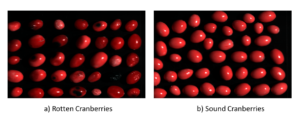At the MLBC lab, we are proud to collaborate with the United States Department of Agriculture. Together, we are exploring how Machine Learning can innovate agricultural practices in New Jersey. Currently, we are focused on developing methods to develop biological insights and improving existing methods related to cranberry cultivation.
CARP – Cranberry Assessment for Rot Prediction
Cranberry fruit rot results from a complex of more than ten filamentous fungi, challenging breeding for resistance. Nonetheless, our collaborative breeding program has fruit rot resistance as a significant target. This program currently relies heavily on manual sorting of sound vs. rotten cranberries. This process is labor-intensive and time- consuming, prompting the need for an automated classification (sound vs. rotten) system. Although many studies have focused on classifying different fruits and vegetables, no such approach has been developed for cranberries yet because of the lack of datasets for conducting the necessary image analyses. This research addresses this gap by introducing a novel image dataset comprising sound and rotten cranberries to facilitate computational analysis. In addition, we developed CARP (Cranberry Assessment for Rot Prediction), a Convolutional Neural Network (CNN) based model to distinguish sound cranberries from rotten ones. The images below are from our recent paper in which we introduced a method and accompanying software tool for segmenting images of cranberries and determining whether the segmented cranberries are sound or unsound.
Our model and source code are publicly available on GitHub: CARP
The dataset collected for this project can be downloaded here: Cranberry Data
